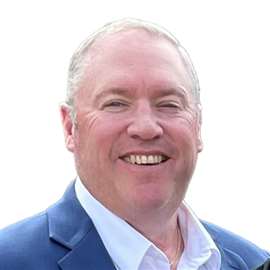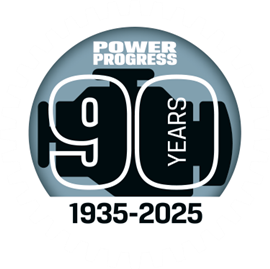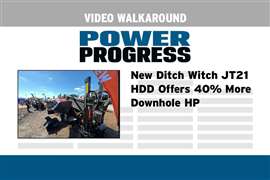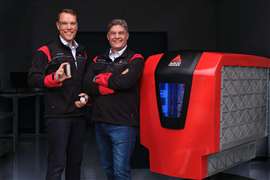Read this article in Français Deutsch Italiano Português Español
Kenworth’s journey to deliver next-gen electric trucks
29 May 2025
One of the first, and perhaps biggest, announcements to come out of ACT Expo 2025 in Anaheim, Calif., was Kenworth’s debut of two new battery-electric vehicles: the next-generation T680E and the all-new T880E, said to be the industry’s first vocational Class 8 battery-electric truck. Both incorporate a ground-up, PACCAR-developed ePowertrain platform.
 The T880E vocational truck will feature factory-installed options for high- and low-voltage ePTO ports to power equipment, a mechanical ePTO or body configurations. (Photo: Becky Schultz)
The T880E vocational truck will feature factory-installed options for high- and low-voltage ePTO ports to power equipment, a mechanical ePTO or body configurations. (Photo: Becky Schultz)
Speaking at the press conference, Joe Adams, Kenworth’s chief engineer, said, “The T680E and the T880E are part of a journey of product development for over five years. We’re now in the validation stage of our program, but we have trucks out on the road. We’ve gathered over 325,000 miles on these new platforms in various applications, and we have over 46 units running in Europe and in North America.”
To learn more about the company’s journey as well as the newest additions to the company’s battery-electric portfolio, Power Progress spoke with Nick Harker, assistant chief engineer, Kenworth Truck Co., at the event.
Q: How has Kenworth evolved in its electrification strategy?
We are a traditional trucking company. We’ve used diesel engines for a very long time. They’ve treated us very well, treated our customers very well. But we’ve seen the shift in the market, and we know that our customers need different options.
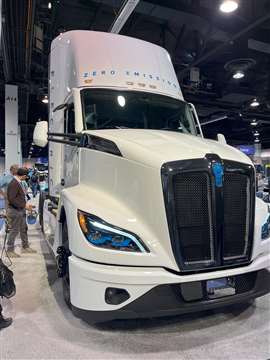 The T680E can deliver 200+ miles of range and is designed for short- and regional-haul, LTL and drayage operations. (Photo: Becky Schultz)
The T680E can deliver 200+ miles of range and is designed for short- and regional-haul, LTL and drayage operations. (Photo: Becky Schultz)
We have trucks that are proven; they can haul freight, they can get the job done. And now we’re evolving the powertrain solution so that you can have that right powertrain to fit whatever your needs might be. That could be driven by regulatory, it could be driven by goals of companies, and even TCO.
In certain spaces, battery electric and other zero emissions [solutions] fit really well; it makes a lot of sense. So, we have been working for quite some time to evolve and develop those options for our customers.
One thing we’ve always prided ourselves on is having a portfolio approach. We have trucks that fit in every different market and do many different things, and the powertrain should be no different. We need to evolve, and we need to make sure that we have that zero-emissions offering and even low emissions with CNG, and we continue to develop our diesel engines too, to be ultra-low NOx to meet all future regulations.
Q: Are you working with partners on development of the technology or are you developing portions of it in-house?
All of the above. When we take an approach where we do a ground up design like we did with our latest generation battery electric, we look at the capabilities we have in house, and then we also work with our strategic partners.
We have a number of partners [where] we leverage their expertise and their folks. For example, we’ve worked to develop an e-motor that works very well for the platform, but that is from another supplier. And you can think of that kind of like Cummins and engines. We’ve used Cummins engines for a very long time. A great partner, and it’s just a great partnership to provide a very capable truck. Same thing with an e-motor.
In-house we do a lot of our own software development, a lot of our own HMI, a lot of our own control strategy, a lot of the design of the truck itself – how to reinforce the frame and hold all the components. That’s all core competencies of Kenworth that we leverage, and we keep that all in-house. And then we work very, very closely with those supplier partners so that we get an integrated powertrain and all those components work really well together.
Q: Let’s discuss the development timeline for electrification. How did that all progress, especially with the latest generation electric truck and the brand-new model that you launched?
We do have a current model out there already. That was a first kind of “cut our teeth.” We partnered with a couple of different suppliers to do most of the design, and we integrated it. So, it’s kind of like taking a kit and putting it into our trucks.
What we quickly realized is that we needed to do our own ground up development. Some reasons for that is we can take away some of the drawbacks of battery electric from an initial purchase price – get that cost down. What we’re able to do is be able to get better range, better charge speeds and just help take some of the concerns out that customers have seen with battery electric.
Q: How do you take electrification and apply it to a work truck that has such varied applications? And how do you overcome the concerns that customers may have that it won’t have sufficient power and capability compared to the trucks they’re used to?
I think you’re getting at it perfectly. That varied application is the challenge with vocational and work trucks because they’re all very different, right? If you look at all the different vocations, bodies, routes, everything is very different.
Kenworth has a long history of strong vocational support. We’ve done vocational trucks from the very beginning, starting with logging trucks. We really pride ourselves in that. And so, we took that approach, knowing that we need that variability and we need to be able to tailor the trucks to be able to do the job appropriately.
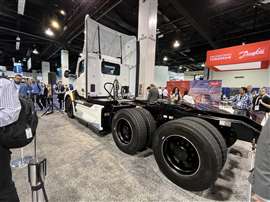 The PACCAR-integrated ePowertrain system incorporates a central drive eMotor positioned in the back half of the truck to allow for configuration flexibility. (Photo: Becky Schultz)
The PACCAR-integrated ePowertrain system incorporates a central drive eMotor positioned in the back half of the truck to allow for configuration flexibility. (Photo: Becky Schultz)
With our latest generation, we went to a midship motor and what that’s allowed us to do is to basically use the whole frame of our traditional Kenworth truck – so the rear axles, rear suspension, the frame rails – it allows us to have that variability. We can do very long trucks, very short trucks for different bodies, different things, and then also bring in key electrified components, like an electronic PTO. You no longer have an engine to be able to make hydraulic power to run your body, so [we] provide e-PTOs that use high voltage to do the same thing.
So essentially, all the things that we know that customers need, we took a step back and developed electrified solutions for them.
I think power pretty much speaks for itself because it’s very capable and, in many cases, actually has more power, more torque than a traditional internal combustion. So that concern, I think even across the industry, has been addressed pretty well... We’ve moved beyond that concern.
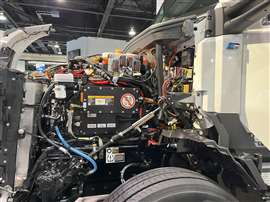 Under the hood of the trucks is a new powertrain and accessory controls module for functions such as electronic HVAC and electronic power steering. (Photo: Becky Schultz)
Under the hood of the trucks is a new powertrain and accessory controls module for functions such as electronic HVAC and electronic power steering. (Photo: Becky Schultz)
What remains is range. There are a lot of range challenges. Purchase costs and then weight would be another one. Batteries are heavy. You can go a long way, but then you don’t have as much payload because you’re carrying batteries.
So, in those areas, range for instance, we work very closely with our customers. We have our sales team evaluate the routes and the way that they’re going to use [the truck], and we work with them to tweak and tailor so that the battery electric can work for them in their operation. Or do our best to spec a truck that has minimal impact on the way that they typically use it.
Going back to the vocational thing, battery electric makes a lot of sense in vocational because a lot of time it’s just out and back, you’re back home to charge it… Where cross country is a little tougher – you get more range anxiety about making it to the next charger. That’s a lot more challenging. If you’re staying in a local area, and you’re always going to be back to your charger at night, there’s a lot less anxiety.
Q: Looking at the features and capabilities, if you had to list three or four key things that are applied in these two new models, what are they?
Our key feature is just having that flexibility. It’s beyond just having frame layouts that work for everyone; it’s also having the powertrain options available. We have a great cab, we have a great chassis – it’s tried, proven in the industry.
Now, being able to have that flexibility and expanding that portfolio so that we have the truck that is right for every job – that’s really where this new-generation battery electric shines... We’re no longer constrained to just a couple of options. It’s now pretty much wide open.
Q: Adoption of electrification hasn’t been as quick as people anticipated. What are the biggest hurdles and how does the technology that Kenworth is introducing help to address them?
Some of the biggest hurdles in traditional trucking are “This is how we’ve always done it. This is how I make money. This is how my grandfather made money. I don’t want to change because I know this formula works.”
Some of the things we can do are we can get some seed units, get one in their operation, show them that it is very powerful, very capable and just demonstrate that. Work it out on paper, but then also show it and have some demo units and some trial type situations to help convince them that “ Yeah, this could work, and this could actually add to my bottom line.”
Ground-up e-powertrain
The T680E and T880E feature the all-new PACCAR-integrated ePowertrain system incorporating a central drive eMotor and are available with multiple configurations of LFP batteries.
“At the heart of the architecture on our trucks is a new midship electric motor that we have designed to help us expand the number of applications that we have across the product line,” said Kenworth’s Joe Adams. “This new emoter allows our customers to move from on-highway and drayage into vocational applications like what you see on the T880E.
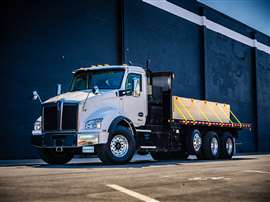 Kenworth T880E battery-electric vocational truck (Photo: Kenworth)
Kenworth T880E battery-electric vocational truck (Photo: Kenworth)
“What’s really unique about the midship motor design is the back half of the truck where the suspension is, where we have our rear axles,” he continued. “Those components can be the same as an internal combustion engine today for all of our very unique custom trucks that are built and driven by our customers that have very specific applications.”
The central drive eMotor and updated vehicle architecture allow for wheelbase flexibility, lift axle installations and vocational-friendly BEV integration, as well as increased battery capacity, charging speeds and drivability.
The ePowertrain system delivers 365-470 hp continuous power and up to 605 hp peak with 1,850 lb.-ft. of torque for both vehicles. The T680E is available with three battery-string configurations offering up to 500 kWh and 200+ miles of range, while the T880E has four battery-string options with up to 625 kWh of energy storage, enabling 250+ miles of range. A CCS1 DC fast charger with a 350-kWh peak charge rate enables charging up to 90% in approximately two hours.
The T880E also offers factory-installed options for high- and low-voltage ePTO ports, which can be utilized to power equipment, a mechanical ePTO or body configurations in conjunction with aftermarket body upfitters.
Both the T680E and T880E come in gross vehicle weight ratings up to 82,000 lb. They are currently available for order in the U.S. and Canada, with delivery anticipated later this year.
POWER SOURCING GUIDE
The trusted reference and buyer’s guide for 83 years
The original “desktop search engine,” guiding nearly 10,000 users in more than 90 countries it is the primary reference for specifications and details on all the components that go into engine systems.
Visit Now
STAY CONNECTED




Receive the information you need when you need it through our world-leading magazines, newsletters and daily briefings.
CONNECT WITH THE TEAM



